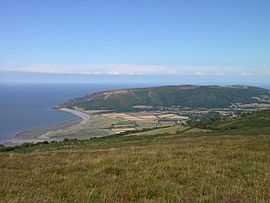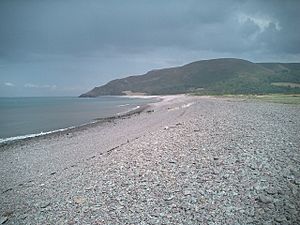Porlock Bay facts for kids

Porlock Bay is a beautiful bay located in Somerset, England. You can find it on the Bristol Channel, nestled between Hurlstone Point and Porlock Weir.
The coastline here is very interesting! It has special features like shingle ridges (piles of small, smooth stones), salt marshes (wetlands flooded by salty water), and even a forest that is now underwater. Long ago, in 1052, a Saxon king named Harold landed here from Ireland. He burned the town before heading towards London.
A lot of this coastline is looked after by the National Trust. This organization helps protect important natural and historical places. The coast is also part of the South West Coast Path, which is a long walking trail.
Contents
Porlock Ridge and Saltmarsh: A Special Place
| Site of Special Scientific Interest | |
 |
|
| Area of Search | Somerset |
|---|---|
| Coordinates | 51°13′09″N 3°36′18″W / 51.21928°N 3.60508°W |
| Interest | Biological |
| Area | 186.3 hectares (1.863 km2; 0.719 sq mi) |
| Notification | 1990 |
Porlock Ridge and Saltmarsh is a very special area covering about 186 hectares (460 acres). It was officially recognized as a Site of Special Scientific Interest (SSSI) in 1990. This means it's a place with important plants, animals, or natural features that need protecting.
This site is important because of its active coastal features. It also has nationally important salt marshes and shingle beaches with plants growing on them.
Near a place called Bossington, there's a shingle beach where the River Horner flows out. In the 1990s, the sea level started to rise. This caused new salt marshes and lagoons (small, shallow lakes) to form behind the shingle bank.
How the Coastline Changes
This area includes a shingle ridge and the salt marsh behind it. It stretches for about 4 kilometers (2.5 miles) along the coast. The way the land changes here is a great example of how coastal areas develop.
In October 1996, a very big storm hit. It caused the shingle ridge to break open in one spot. This allowed salty seawater to flood the marsh, which used to be freshwater farmland. The storm created a brand new tidal lagoon. Since then, this lagoon has been growing quickly, with small creeks forming. Land that was once used for farming is now a tidal salt marsh.
Amazing Plants and Animals
A big part of this site is a lower salt marsh. Here, you'll find lots of plants like common glasswort (Salicornia europaea) and sea-blite (Suaeda maritima). You can also find a rare plant called Babington’s leek (Allium ampeloprasum ssp. babingtonii).
Many birds visit this site regularly. You might see grey herons (Ardea cinerea), little egrets (Egretta garzetta), and shelducks (Tadorna tadorna). In winter, small groups of lapwings (Vanellus vanellus), curlews (Numenius arquata), and teal (Anas crecca) can be seen. Many different types of birds also stop here during their long migrations.
In 2013, an oyster farm was started in the bay. The first oysters were ready to be harvested in 2016.
The Submerged Forest
If you visit Porlock Beach at low tide, you might see the remains of a submerged forest. This means there are tree stumps and roots that are now underwater.
This area was actually several miles inland a very long time ago. About 7,000 to 8,000 years ago, the sea level in the Bristol Channel rose. This caused the forest to become covered by the sea, turning it into the fascinating underwater remains we see today.

